In 1956 before Ishiyama Osamu entered the junior high, he, together with other youngsters, took a field trip to the Hiroshima Peace Center, and the then 6th grade had got the impression that Tange Kenzou weighed up the significance of Theme Park a bit heavier than the meanings of other kinds. Tange, perhaps, esteemed Peace the primary subject matter to address his design and, unintentionally, put the remembrances and solace for the dead and the alive the secondary concern. The Hiroshima Peace Center happens to be the official memorial center for the Obon (���~) festival each August; the governmental officials and the oversea representatives are to be present for the annual memorial service, at the Hiroshima Peace Center at 8 a.m. on 6 of August, and the civilian public are to do the gardening of the tomb sites of their ancestors. That is, this design is meek in extending the horrific living memories of the disaster to condemn the use of weapon of mass destruction, without mentioning the fact that the survivors are fading away.
The American peace activist Dr. Floyd Schmoe, scholar in Forestry and Ecology, came to Hiroshima in 1948 with his self-raised 4 thousand US dollars, together with a group of student volunteers from Tokyo and Hiroshima, built 4 sets of fukkoujyutaku, Recovery Residences, in that summer; and, in the following year they built additional 20 ones to refuge some 500 families. Those fukkoujyutaku, in terms of the Japanese economic recovery power in the 50s, were better to be termed �fukkou-homeless shelter,� rain-n-wind resistant, yet rough and uncomfortable. Today, only one of them is left in the name of kouminkan for remembrance activities regarding to the tragedy. The local people call it Hiroshima House. What Dr. Schmoe did was more than a chivalry charity directly benefiting the war-homeless, but, with the left kouminkan, he was to extend the mercy from the American people, without any political motivation, to care the Hiroshima war-refugee. This made the difference between the Hiroshima House and the Hiroshima Peace Center.
In November 2006 the Phnom Pehn Hiroshima House designed by the Ishiyama Lab., Waseda University was officially opened to the public in the capital city of Cambodia, 27 years after the Pol pot regime (1975-79). Contributed by the donation�_�]�from the Hiroshima citizens, who, with the horror of the atomic bomb tragedy, could better understand how the Cambodians had suffered through the horrors than any other city can. Realistically is it to be used for the peaceful purposes like child-education, medical care and welfare, apart from the exhibition and remembrance for the holocaust. The design was motivated by the intention to prolong the memories of the horrors in genocides, seeking to alert the coming generation and urge the evils to repent.
From the French colonization (1863-1953), Phnom Pehn, nicked named �little Paris,� has the check-board city planning with lots of square blocks. The site is donated by the Unaromu Temple; west to Tonle Sap River being confluent with Mekong to her East, the Hiroshima House, 2 blocks north by south to the Palace, is located in the block in which, according to Mr. Shibui, a scholar in Buddhism and teacher of Japanese language, the country�s high monks are dwelling. As a Buddhist myself I somewhat understand that the Hinayana Buddhism has been popular in the south-east Asia for centuries; and thus it is worth seeing how a Japanese architect, with the duel backgrounds in Shintoukyou�i���D�Ёjand Mahayana Buddhism, designed this project to address his intended philosophy in dialogue with the local belief.
The Buddhism was first introduced to Japan in 538A.D. by the Seimyou king ( ������ ) of Kudara ( �S�Z ) in the Korea Peninsula. �Brilliant!� sighed by Kinmei Tennou ( �Ԗ��V�c ), who came to throne in 540A.D, and began his patronage of Buddhism; which yet threatened the then Shintoukyou ( �_�� ) group originated from the Japanese tradition. Here,�uShin�vrefers to the deity, or divine being in Kojiki ( �Î��L ) or Nihonshoki ( ���{���I ) Following the assassination of the Shintoukyou-sided Susyun Tennou ( ���s�V�c ) in 592A.D, Buddhism, with the support from Shoutokutaishi ( �������q 574-622 A.D. ), was advancing in full sail throughout Japan and reached the prime era in the regime of Koutoku Tennou ( �F���V�c 645-54A.D.) Shintoukyou subsided and re-appeared in the name of shinbutsusyugou ( �_���K�� ) ; i.e., deity and Buddha are learning from each other. The way of learning is the so-called Honjisuiseki ( �{�n���� ); that is, Buddha, Kannon or Jizou are arriving at the Shrine and appearing in the form of Japanese deity. For instance, in the konpira shrine ( ���䗅�{ ) of Kotohiramachi, Kagawa prefecture, the Shakanyorai ( �߉ޔ@�� ) and Fudoumyouou ( �s������ ) take the shape of konpiradaigongen ( ���䗅�匠�� ) and reside in the shrine. Meiji Tennou (1852-1912 A.D) promulgated the abandonment of Buddism Haibutsukishaku ( �p���ʎ� ), yet Buddhism has been deeply rooted in Japan.
As the Hiroshima House was motivated by recollecting the horrors of the Atomic Bomb disaster and offering a condolence to the Cambodians� suffering from genocide, it might just as well to recall the historical cities� then being devastated by aerial area bombardment in the European theatre particularly in Germany, and see how England and Germany, both believing in Christianity and being cultivated from the Renaissance, managed to heal their wounds. The most devastated city, Dresden, having been restored by the modern architectural preservation engineering with the potent German economics and donations from celebrities like Queen Elizabeth II and Dr. G�nter Blobel, who hosted a concert in Berlin in November 2004 to raise fund for restoring Dresden Frauenkirche, Church of our lady, and gave his Nobel Prize money to the city, is appearing in her reincarnated image as the symbol of the Baroque Humanism. The Germans� eagerness to see the pre-war Dresden can be understood from how the Dresden ruins have impacted her visitors by bringing them to the horrific scene. Such impact, within the Chinese context for instance, was as equally embittered as seeing the ruins done by the Anglo- French joined armies� looting and incinerating of the Royal Yuan-ming Garden ( ������ ) in 1860, the 10th year of Shenfohn Emperor. This then so-called �the Garden of the 10 thousand,� was joint-designed by the court artists and the Jesuit priests, like Giuseppe Castiglione ( �Y���J1688-1766) from Italy, and built during 1709-70A.D. symbolizing the heydays of the Celestial Empire of Cathay through the regimes of the 3 emperors, kanshih ( �N� ), Yungchen ( 贐� ) and Chanlon ( ���� ) (1661-1799), is today nothing but wasted and abused pillars and foundation with traces of Baroque-styled carving, leaving the Chinese people historical regrets and resentments ever since.
I have not see Dresden Frauenkirche myself except the photo images, but I can see the significance as God�s shelter offering the believers the spiritual comforts as other cathedrals bear, apart from her historical value. In the relatively indigent 60s in Taiwan, I quite often attended a Presbyterian Sunday school, learning to read Bible, singing the Psalm, and, enjoying a hot meal generously prepared afterwards by the pastor and his staff, who, without any arch-eyebrow superiority, taught us that the food and the church as a shelter were from God�s blessing. Even today, I regard Christianity as my soul�s backup and never see any problem that a Buddhist and a Christian walk side by side sharing wisdom. In the New Year eve of 1987, since the revelry in downtown was noisy, I sought retreat by attending the Notre-Dame de Montr�al Basilique, walking there by the river bank of St. Lawrence. The floating ice blocks, under the street lighting, could be seen leaning on each by each, advancing towards the cold and dark north. This scene reminded me of the last few lines of Joseph Conrad�s Heart of Darkness cited below; perhaps 100 years ago he had been possessed by a pessimistic view about last century.
�I raised my head. The offing was barred by a black bank of clouds, and the tranquil waterway leading to the uttermost ends of the earth flowed somber under an overcast sky--seemed to lead into the heart of an immense darkness.�
Before I reached the Basilica the fireworks performance began; a loud and heavy �bang� followed as soon as the fire circle of an explosion was widening, the golden embers rained down and disappeared with cold breeze. Were those the flares dropped by the Luftwaffe Heinkel, or perhaps by the RAF Mosquito? I felt agitated, puffing a full blow of white fog out of my lung, quickly stepped into the Basilica. At the entrance hall I dipped my fingers into the stoup�s holy water, tapping my forehead with one knee down. There, around 30-40 people were sitting in the ground hall, lowering their faces and praying, and before joining them I lit a 3-inch white candle and placed it on the candle wall. The heat generating from the candle walls made the air wavering up in the hall, and the vertically swirling air flow aided by hundreds of candle lights helped render the images of saints and angels troweled on the color window glasses as if they were re-incarnated and welcoming the arrival of the Virgin Mary.
Sitting on the cushion, comfortable and warm, one grey hair women shared her prayer book with me; It was Rosary and I twisted the right-hand side of the page with my left hand fingers although I cannot read French. Yet, I could not do any meditation or praying since the police car�s jarring siren kept disturbing the peace inside the Basilica, despite the siren was only like Mosquito�s humming. The Virgin Mary�s face in my eyes looked like Kannonsama ( �ω� ) bodhisattva, and my pulses and heart beats were getting steady.
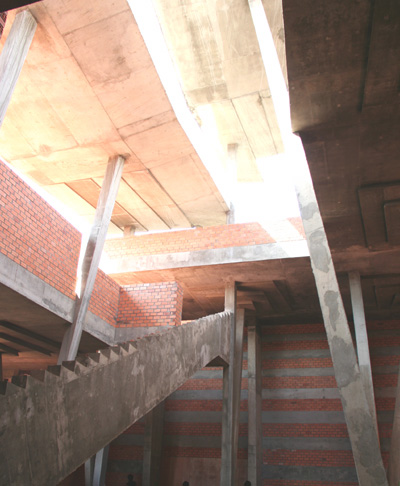
Coming and going between the Okubo Campus and my apartment via the used-book-street on the Waseda Ave. ( ����c�� ) everyday, I quite often stop by the ones selling the books with photos of gold-plated bronze statues of Shaka ( �߉� ), Kannon ( �ω� ) and various Tennou ( �V�� ) preserved in the temples in Nara and elsewhere, lingering on after the last customer has left. Besides shrines (�_��) and temples, quite a few small jizou ( �n�� ) huts were built in an area of a couple tsubo ( �� 3.3�F) in Tokyo. There is one humbly residing in the confluence where the Waseda Tori and a narrow alley unite. Hiding behind those wood-framed book stores and noodle shops, where the pedestrians were baptized in the buzzing of driving through cars and the yelling of �irahshaimase,� the stone jizou was thrown on a dark red cotton shawl and his dim facial features under a red kerchief covering the blurrily engraved head made himself look like a ghost, squinting his eyes and peering through the human flow, studying every passerby. The local people said it was built after the 20th year of Shouwa; i.e. after the war. Whenever I passed by I clasped my palms, lowered my head and chanted the 7-kanji phrases ( ) for peace:�una mu ji zou ou bo satsu�v( �얳�n������F ) or�una mu kan ze on bo satsu�v( �얳�ϐ�����F ), and then I threw a hyaku-yen coin into the wood box written jyouzai ( ��� ). This throwing act, as the coin hit the wood frame, produced a tong-sound, followed by a ching-sound as the coin dropped into other coins. The couple of nasal sounds�/n/�somehow acupunctured my nerve fibers as the 108-bell-sounds in the New Year eve moved my heart. What are the jizou huts here and there for? Jizou bosatsu made the vow that he shall not ascend the Buddha ( ���� ) from his bodhisattva ( ) status until he saves all the suffering in hell. Perhaps I am living in a hell called Earth; the pictures of Hiroshima the wasted land and Phnom Pehn genocide emerge to whirl and rustle throughout the shocking scenes in my mind.
Albeit 30 years had passed after the 2nd World War the remembrance of the holocaust seemed fresh, the genocide yet happened again in Cambodia. In the 90s Ruwanda, Africa and Bosnia, Eastern Europe were also devastated by genocides, the former was due to the tribe conflicts, losing nearly a million people, and the latter, their historical tussles between Muslin and Orthodox, was stopped by NATO before getting beyond control. Earlier at the beginning of this century, the genocide taken place between Sudan and Darfur cost another hundreds of thousands of lives. The exact numbers of cost lives, counted by million, are available from Internet. As a child, I saw people trying to burn down the ant nest in the bushes, some 4 or 5 hemispheres in basketball size piled on each other; they first sprayed volatile oil and set fire on them, hundreds and thousands of black ants came out of and ran away from the hemispheres. They swabbed the killed into two buckets. Less than 5 thousands, I guessed. What seemed most horrified about the Pol Pot genocide was that it occurred among the Cambodians themselves. Looking at the skull-piled shelve walls, the heaped skulls like harvested melons stored in the warehouse, under the pagoda, and the newspaper-size post printed with rows and rows of black and white I.D. size photos, I wonder what specie of animals could have such kind of insatiable appetite for blood, no, no animal of whatsoever kind could possibly did so. It is homo sapiens who know how to hate.
To escape such genocides, the southeastern Asians could not run away very far from homes. The Europeans fled and took refuges in America, and I happened to know several of them. In June 1995 I left Los Angeles for Port Alberni in Vancouver Island by 2 days� driving northbound through Highway One and entered British Columbia, and from Port Vancouver I pulled in the Sea Cat, ferrying to the most western territory of Canada. It was fun watching the sea coasts and marine life on uninhabited islands in all kinds of weather. Paunchy seals sunbathing on the rocks where the water met the cliff, and hundreds of Sea gulls and sea crows hovering 20 feet above the deck, nose-diving to peck the tossed flakes of toast and potato chips, I made a wish that it be a war-free country forever, watching overhead a few dozens of diving petrels whistling peeh-peeh, peeh-peeh as they were climbing and pe-pe-pe-pe diving like a war bird�shidenkai ( ���d�� )�aiming at USS Yorktown through the web of anti-air shells, for Christ�s sake! The Alberni Inlet is pocketed by a pair of arms of wide green vegetation, forests of cypress, firs, oaks and pines holding up mountains with white top, as if huge white Christmas pudding cakes decorated with conifer twists. Small lakes and creeks are found there, cold and crisp, crystal and undisturbed. L.A. to Port Alberni is like one way trip from the mundane to Heaven Ureriten ( �@���V ). The major population in Port Alberni is American Indians, and that of European descent comes next. Every Saturday 2 or 3 Indians would invite me to fishing Salmon and trout in the forest. They, or their Husky dogs, knew how to avoid cougars, for a few winters before an Olympic ski trainee got attacked by a big cat and badly wounded. They impaled the scaled salmons through the mouths with sticks and baked them in barbeque style, and the removed eggs that made at least 5 rolls of 300-yen a piece salmon eggs sushi, together with fish heads, liver, and stomach were placed in a plastic tray and left there close to the huge oak trees far away from the camp fire. A couple of white-head eagles perching on the trunk, waiting, then glided down at the service. Surprisingly, the Husky let the birds take care of their own business. Several fox-squirrels appeared, and I gave them a share of my rice. The Indians told me that the eagle was too proud to take a squirrel its prey and an owl only hunted at night. The preys are said to be the ancestors of the Indians.
I usually gave the left whole salmon, head to tail fin, to my European neighbors and they, in exchange, invited me for dinner. They, the Versteeg, introduced themselves as Dutch at first, and later on in the summer of 1993 as I served their daughter�s wedding as a camera man, they told me in the reception, perhaps for my yellow face and Leica, or perhaps after popping a few bottles of champing, that they were from Bremen, a northern German harbor. They came here, bypassing Toronto and Montreal, to the then seemingly uninhabited Island for jobs in timber mills. Another family left Wetzlar, where he had worked as an optical technician for 8 years, for Alberni for the same reason, having run a camera repairing shop in Vancouver and commuting between 2 places in the weekends since 70s. In the living room an oil-painting of his father was hanging on the wall with a glass box below in which an iron cross medal and decorations from the German Army were pinned on silver flannelette. His father, killed in the Eastern front, was an officer ranking captain, and the painting was done and brought back by his adjunct in 1945. In the area of Hope, two hours by car from Vancouver eastbound along Fraser River, or even farther to the Okanagan Valley where orchards and vine yards make the landscape, there are immigrants from Germany, Hungary and Yugoslavia living on viniculture. They produce perfectly aged ice wine. �We came to Canada for a shelter,� said one of them, and gave me the business card showing a van before his last name.
During the dinner with the Versteeg, their TV set was on showing a digital-updated BBC documentary series�The World in War�for the 50th anniversary of the V-E Day. Their grandchildren enjoyed the scenes like Erich Hartmann the honky airman, as a Hollywood superstar, scored his 300 something wins, and together I watched it with less attention to the scenario than the illustrations of the war tool designs from both sides by BBC�s modern animation techniques, for, that a Spitfire Super-marine distinguished herself and differed in shape and form from a Me 109 seemed to predestine respectively the shapes between a now Jaguar and a Mercedes, an Aston Martin and a Porsche; the bubble cockpit of a Spitfire and her streamline curve wings reincarnated the sleek Aston Martin and the elegant Jaguar with her Greek-pillared engine hood, and, likewise, the square-inclined, geometrically shaped war bird design predicted the boxy and solid, or, if you like, Bauhaus Stuttgart autos. Yet, no sooner had my daydream of shifting up to the 5th gear in a Boxster on Highway One just started flashing between my ears than it was held back, as the living room seemed frozen by Mrs. Versteeg�s sobbing.
It was BBC�s documentary showing the scene of Anglo-American�s area bombardment over the cities in Germany and Japan in 1945. The living room darkened with solemn air as it came to the Dresden catastrophe. I heard phrases like �the Florence of the North� and �the finest German cultural gem� from the commentator. For those Asian people, who are week imagining the destruction of Dresden�s value as the historical treasure in the Continental Europe, might just as well try to imagine otherwise that the Luftwaffe had ruined Cambridge, Oxford or �the Athens of the North��Edinburgh. The 27 inch black and white scene showed two huge white clouds hovering over the devastating 15 km_bombed Dresden, which, as �Devil�s Tinder Box� said the TV seen from a camera above, was like a smelting furnace with the temperature up to 1500�C, covered with black coals, and the fissures on which exposed themselves in darkness with twinkling white spots. Following the scene, a gloved finger, at 08: 15, 6 of August, pressed the bottom and yielded a 1,800�C oblivion underneath a mushroom cloud over Hiroshima. I squirmed through the dinner, rarely afforded any other appetite than staring at the slightly eaten plates of good food set on the table in front of me, and left.
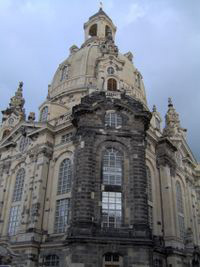
Dresden Frauenkirche : View of the south side of the Frauenkirche in 2006, showing the incorporation of the largest remaining fragment of the original structure
The Dresden catastrophe said above was the result of the RAF night air-raid from the late night of the 13th to the early morning of the 14th of February 1945. Started at 22: 14 Central European Time, 796 Lancaster approaching from two directions, dropped 1,478 tons of high explosive, and 1,182 tons of incendiary bombs in 2 minutes, and at 22:22, 244 Lancaster dropped 800 tons. After 178 minutes the 2nd group of 529 Lancaster came at 01:21- 01:45 and left 1,800 tons. American B-17 came twice afterwards in daytime.
I have no intention to write an article for a library already full of such discussion or debates about the controversial issue if the end should or should not justify the means, for though the end of finishing up the dirty business is always right. War has been a dirty game, It was not a fare game played by rules between two Teutonic knights jousting for the pleasure of the ancient kings and his jesters, and his mistress. People, who started the war, somehow tended to validate whatever the motivations were with romantic coatings to justify themselves for their followers. And, there are people, young and old, like the Versteeg grandchildren saw the romantic aspects, like the Blond Knight Hartmann or the Kamikaze airmen, without witnessing both Hartmann�s hard time in the POW camp in Russia and the mothers crying in anguish for losing their sons in the Pacific Ocean. And what Ishiyama lab. wish to remind people of with Hiroshima House in Phnom Pehn are the horrors of war and genocide. And, as an Asian and a Buddhist I wish to remind the Asian peoples as well, who are remote to the European tragedies, of the horrors of unnecessary bombing over the cities not only of Humanistic heritages and beauty but of women, children, old men, maimed veterans and refugees. Unnecessary? The utter destruction of Dresden was, from today�s view, a result of using the weapon of mass destruction, was it not?
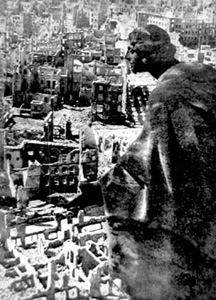
August Schreitmueller's sandstone sculpture "The Goodness" looks over destroyed Dresden from the Town Hall Tower in 1945
The mutual application of high explosive and incendiary bombs was the major strategy contributing to the horrors of the bombing zone. The bombers came and dropped the explosives to blast off the roofing and make the internal structures, timbers and flammables, exposed to the following incendiary bombs, which were set up to explode in air, spread about the incendiary sticks and rained down to fuel the bombing area. Then, the following wave of high explosives enhanced the burning services. The worst was yet just about to begin; as the prolonged combustion effect baked the fixed 15�H_region an oven of temperature as high as 1500�C, exhaling the hot air upwards rapidly to compose the two huge white clouds mentioned above, February cold air simultaneously got sucked into the fire zone from the ground level, and those not lying prone on the ground, children and the meek, were pushed in the unspeakable atrocity by the fire storm.
As opposed to Water, where White Lotus are found, Fire, as written in the True Will Sutra of Jizou�Ksitigarbha�Bodhisattva ( �n�U��F�{���S ), has been the major element that keeps tormenting the suffering in hell, or, the hell on earth. The Mugenjigoku ( ���Ԓn�� : the hell non-stop in time and continuous in space), as described in Book 3 of the Sutra, is surrounded by the wall of 10 thousand mills in height ( ���ꖜ�� ) and of 80 thousand miles in circumference ( �����P�� ). The long wall, inch by inch, has been burning in flame without gaps. In the center called Mugen ( ���� ), encircled by the wall 1 thousand miles in height ( ����痢 ) and 18 thousand miles in circumference ( �ꖜ�����P�� ), there driving-through iron snakes and iron dogs ( �S�֓S�� ), spitting fire ( �f�Βy�� ) through the vertically whirling fire webs, are treading on hundreds and thousands, or even millions of sinners, perpetually. The hells ghosts, eyes like torch, teeth like blade, make ones hold the burning iron post in arms, pull their tongues, pour to fill the jaws with melting brass ( _����� ), drag their limbs with brass claws ( �蕜����__�ߐl ), and so on and so forth. Hundreds and thousands of hells other than Mugen are there, like hells of fire elephants, of burning hands, of burning feet, of fire dogs, of fire horses, of fire hills, of fire rocks, of fire beds, of fire eagles, of fire wolves, of fire house ( �Ή��n�� ) and of others including the hell of glacial land ( ���u�n�� ). Four major Tools for torture implement, as written in Book 5�Names of the Hells� are of iron, of brass, of rocks and of fire. Dresden, through the midnight of 14 till the dawn of 15, February 1945, was the firework rituals climaxed by cremation in the hell of fire, and a pagan burning ground straight out of the Dark Ages put to be observed by those who promised Ares to vow an eye for an eye; who esteemed the winning of war the ultimate end that surpassed anything else.
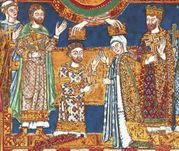
Coronation of Henry the Lion and Matilda of England (1188AD).
Braunschweig, Henry the Lion�s city, built by Heinrich der L�we (1129- 95 AD), was the first fatality of such strategic bombing, and the memories of horror witnessed by the fire fighters and refugees shall be vigilant, perpetually, to humanity and civilization. It happened on 14-15 October, 1944; 7 pathfinder bombers, coming at 23:00 of the 14th, dropped 60 flares in turn about 1,000 meters above the Cathedral, and the flares got parachuted down in air as the 12 o�clock position for each of the 233 Lancaster coming in the 120-degree sector zone from the arc curve at the 1173-95AD built Mediaeval Cathedral as the target center of attack. �Visibility: excellent,� said a RAF observer. The 1st wave air raid ended at about 24:00, left 6 imperial tones of bombs, each. The siren for the 2nd wave sounded at 01:50, the bombing began at 02:30 and the all-clear siren sounded at 03:10. The fire storm was reaching its peak; it was too hot to reach the trapped refugees, some 23,000, in 6 bunkers and 2 anti-air shelters spread in the flaming mediaeval town. Mostly women and children, and men were either too old or maimed to shoulder a bazooka, or too young to join the Hitler Youth. They would die of suffocation before get burned, for though the bunkers could resist the approaching fire the combustion burned up the oxygen. It was Rudolf Prescher (1912-97), the fire fighter captain, who figured out the rescue solution at 5:00. In order to minimize the heat, they created the �water alley� between the bunker, each, and the hydrants by punching the water pipes to make blowholes, spurting water to make �raining zones.� 23,000 lives were saved from 6 bunkers and 1 shelter. The last shelter, which housed 104, had 95 casualties of suffocation before the rescuing squad reached. The number�23,000�is by and large the half seats of Tokyo Dome; and, just imaging as well the hardness that the Tokyo fire fighters and the self defense force were trying to evacuate 23,000 from Tokyo Dome, had a 9 degree earthquake, or a terrorist attack, struck Tokyo area, not even considering the ill-equipped fire fighters in the war time Braunschweig, who were trying to save peoples from separated bunkers and shelters. Such kind of suffering and horror could hardly be imagined and sympathetic except by those survived from Pol pot�s S-21 death chamber and the like.
Historian Frederick Taylor, in an interview held by der Spiegel, February 2005, suspected that the 2nd wave air raid over Dresden was an intentional attack against the fire fighters and rescuing crew, for, the 178 minutes gap between the raids were long enough to urge them, who were edgy to reach the bunkers, to get in the bombed zone and be bombed by the 2nd wave.
Understandably, the Allies desperately wanted to stop the war with very few choices in hand; yet the objectives to bomb Dresden: (1) destroy the military works; (2) paralyze the railroad transport to hamper the enemy�s maneuverability, were not satisfactory from the military viewpoint, except their wishes like making the allies� air power visible to the Russians, which, arguably, aroused Soviet Union�s vigilance to the West and embedded the following Cold War. The air raids did impair but not destroy the military industries or the railroad system. Albert Speer, the able minister of armament, did prepare the worst and manage to restore the industry; the Dresden railroad system was paralyzed for 4 days, a temporary inconvenience for 96 hours or less. Dresden had 640,000 populations in 1939 and, as the major traffic axis in Eastern Germany, 200,000 refugees fled from Eastern Prussia and trains of the wounded evacuating from the Eastern front were coming in. The air raids left the forever regret of ruining the city and over 50,000 civilian casualties, 80 days before the V-E Day.
The meaning of winning the war was lost in the horrors of memories of human beings burning alive, of sky bombs showering burning shards of incendiary sticks over the mediaeval cities, Coventry, Braunschweig, Tokyo and elsewhere, of replacing the Generalissimo with the Big Brother, of replacing the hell of fire with the hell of glacial land. Since 1943, George Kennedy Allen Bell (1883� 1958), the Anglican Bishop, had been strongly opposing such kind of area bombing to devastate cities and civilians; Christ�s voice is never louder than Ares�.
Under the twelve noon sun, hot and humid, a monk row in sweat-soaked tangerine cassock, holding bowls to accept the food handed in by the donors, made their daily courses. Their facial expressions were emotionlessly plain and the donors� humble and committed. Neither was it begging nor giving, rather, it was a Buddhist ritual founded by Siddhartha (563- 483 BC) 2,500 years before and made a common scene and an identity of Phnom Pehn. The tangerine dragon piercing through the mundane daily life on the pit-holed, mud-caked alleys, walking on the streets of French balcony buildings through the clamour Central Markets, as if the sun rays were cutting in the raining season humidity�an air of unease having hung on the city perhaps since the warfare and genocide last century, magnetized the tourists� camcorders and heartened her citizens with spiritual strength. Most Cambodians, with few exceptions, are Hinayana Buddhists, who, striving for life to obtain the arakan�s (������ ) mental states of relieves from greed/desire ( �� ), annoyance( �� ), and wishful thinking ( � ), are longing to pass their next transmigration and ascend the Pure Land ( �ēy ); a Mahayana Buddhist, also, attempts to do so except that he/she seeks to help the human beings in general reach such states as well. For instance, what Dr. Schmoe worked for Hiroshima made himself a Mahayana Buddhist.
The city�s facial expression of uneasiness appeared immediately from observing the local Cambodians, who were besieged by an atmosphere of �fear� having hung in the air since the genocide and perhaps in her surrounding in which un-removed mines and reptiles are hidden. In the trade fairs there near the temples and the Central Market, say, a woman in her 50s, bent over by her bowed spine, timidly squatted with her bamboo shoulder pole lifting up two baskets of duck eggs on the side walk, her feet rough as bark in un-fitting sandals, her eyes glassy with expectation and fear. A couple of women, facing the foreign tourists, also looked restless, sitting on the footstools and trying to sell white candles, incense sticks and coconuts for offering the divinity in the temple. What were they afraid of, a bad day for business, or next warfare? The affluent, erect and slightly paunchy French diplomats were replaced by tourists, Americans or Europeans, wearing sunglasses and holding camcorders, putting on T-shirts and tartan short pants, proudly stretching his wheat-skinned, soccer-man calves. They gave the women hope and expectation on the one hand, stress and fear on the other; they came as the conquerors in the guises of business and pleasure; they pushed up the economics a bit and bought the dignities from their daughters.
They are unlike the people of Tokyo in the 1950s, who, humbly and vigilantly confronting the crisis in the Korea Peninsula, were working with vitality to face the world in confidence. The withered heart was pumped up with young blood; a Hitotsubashi undergraduate, 23, was awarded the Akutagawa Prize in 1955 for his novel�Taiyou-no-kisetsu, and the athletics were endeavoring to earn dignity in the coming 1964 Olympic, highlighted by their winning of the Women�s Volleyball tournament against the USSR. From under the Nijubashi Bridge ( ��d�� ) and through the grass mound beneath the defensive wall above the moat, the honey-sweet prairie wind was wafted to urge the spring�s first sprouts of juvenile foliages of the black pinery in the Koukyo Outer Garden and, promised each year to be more fertile and prosperous than the previous season. There were unhappy nationals for sure; yet, they would not be driven to escape from home by �fear.�
If there is anything, besides the genocide and daily life anxiety, that physically makes the egg-selling woman unease, it is the natural surrounding of the city and the northern Angkor Wat big lake area, which, ironically, is a major magnet that both chills and excites the tourists. They tour the country as if hunting crocodiles in the Louisiana swamp, canoeing the Amazon in Brazil or playing Indiana Jones, the Hollywood hero, in daring the ghost-haunted Ta Prohm Temple.
Angkor Wat, built like a stone stronghold erected in the jungle, served to defend itself from the cannibals, their enemies and the ghosts hidden in the surrounding; it was also a shelter used to compromise the fear having come over from the immense Greenness in which a pair of huge lungs was breathing since the 13th century. Inside the stone walls there depicted a Buddhist paradise; sculptures of the dancing Shiva, the female dancers with rich bare breast, statures of cross-legged sitting Buddha and stone walls with smiling faces all portrayed the happiness only found in the Heaven Ureriten ( _���V ). Yet, the Angkor civilization had not escaped the ravages of nature�s striking back, as if the paradise were besieged and taken prisoners by the ghosts from the Greenness. The tree-roots tied Buddha reduced to a moss-grown figure curled by boa-constrictor and the dancer�s skin-peeled bare breast reduced to black, blurred sandy traces, as if they were caught by the eye-contact of the snake-haired Medusa and reduced to fossils. Only every night, a ghost posse, suddenly materializing in the swirling miasma, conducts the insect�s calls and the beast�s howling, performing the symphony of darkness. And, the river, ceaselessly, flowed head-on the land where the B-52s had dropped their bombs. Every Cambodian, perhaps, was determined to be a Hinayana Buddhist by such fear.
Had the Shaka ( �߉� ), Kannon( �ω� )and various Tennou ( �V�� ) deserted the country? No, any form of life and beauty entail death and decay, fleshes reduced to corpses, palaces reduced to rubbles and ruins and, yet their spirits last. Angkor Wat, or even Dresden could not escape from the circulation of life and death, a rule governed by Shiva in Hinduism, which could be interpreted by a poem written by Aldous Huxley in his�Island�published in 1962:
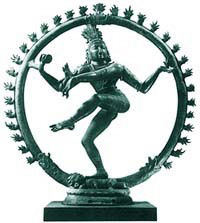
Who in sunlight dance among the birds and the children at their play,
Who at midnight dance among corpses in the burning grounds,�@
You Shiva, you dark and terrible Bhairava,
You Suchness and Illusion, the Void and All Things, ----5
You are the lord of life, and therefore I have brought you flowers;
You are the lord of death, and therefore I have brought you my heart---
This heart that is now your burning ground.
Ignorance there and self shall be consumed by with fire.
That you may dance, Bhairava, among the ashes. ----10
That you may dance, Lord Shiva, in a place of flowers,
And I dance with you.
Perhaps, a Buddhist, Hinayana or Mahayana, is a passive nihilist from Nietzsche�s view in that a Buddhist is lacking of the power of destruction�Zerst�rung�possessed by an active nihilist. Yet, a Buddhist, if not a Buddhist by name, must act; his action is practicing the self-deny in Buddhist teachings, ascetic and meditation, for instance; thus, he may be liberated from suffering from his striving to obtain the power of destruction by which the self, as listed in line 9 above, can be destroyed�Nein sagte; he may therefore liberate himself from the life full of unpredictability ( �ނ��傤���� ) and absurdness( ���� ) and may simultaneously live in the life with joy. The self, composed of the 3 major toxic chemicals in man�s soul�greed/desire ( �� ), annoyance( �� ), and wishful thinking ( � )� leads the man in eternal torment.
The design is bitterly spiritual, rather than organically material; the Hiroshima House in Phnom Pehn deserves a place in Buddhism, for its power to change people�fs moods if not to enlighten people�fs minds, and a place in Humanitarianism in that Hiroshima, or even Japan, wishes to offer the ill-fated country her sympathy and simultaneously makes a worldly statement for denouncing war and slaughter. Albeit planed for memorial and humanitarian purposes, offering spaces for temporary medical care, exhibition or orphanage, what this architectural work could offer is, material-wise, very limited. Yet its powers of enlightenment (���) and deliverance (��E), either for an individual or at national level, is rich. Locally, it broadens the ascetic practice (�C�s) horizon for the Cambodian monks and the visitors, and internationally it urges a nation to respect peace and helps her nationals see the war and the holocaust as the consequences of nationalism.
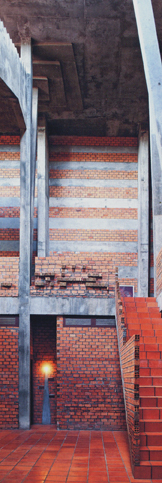 Painfully erected by the pull-apart concrete posts, are the pair of bended rectangular concrete slabs designed by the motivations of a local myth about the foot prints (����) left by Buddha�fs secret visits? Or, is it perhaps designed by the sky bomb memories, imitating the defense fortifications for the bunker right beneath? Are the tilted concrete posts also the mimicries of the Hiroshima ruins? Or, perhaps the Buddha has stepped upon the devastated country and left a heavy blessing, or perhaps Shiva might just leave her dancing steps as well, inviting the souls from the S-21 for a dance in the sky. The horizontally barred, concrete and brick alternating walls make the building look either like a fortified defensive banker, a jail or a concentration camp, for the coarse texture and color of the local bricks fill up my mind with images and images of bricks, the local brick pagodas deposited with piles of skulls, steel bars and the brick-piled arched opening, one by one, along the corpse-burning hall over 60 years ago in Europe.
Painfully erected by the pull-apart concrete posts, are the pair of bended rectangular concrete slabs designed by the motivations of a local myth about the foot prints (����) left by Buddha�fs secret visits? Or, is it perhaps designed by the sky bomb memories, imitating the defense fortifications for the bunker right beneath? Are the tilted concrete posts also the mimicries of the Hiroshima ruins? Or, perhaps the Buddha has stepped upon the devastated country and left a heavy blessing, or perhaps Shiva might just leave her dancing steps as well, inviting the souls from the S-21 for a dance in the sky. The horizontally barred, concrete and brick alternating walls make the building look either like a fortified defensive banker, a jail or a concentration camp, for the coarse texture and color of the local bricks fill up my mind with images and images of bricks, the local brick pagodas deposited with piles of skulls, steel bars and the brick-piled arched opening, one by one, along the corpse-burning hall over 60 years ago in Europe.
As I entered the main volume�fs 2nd floor with the city�fs worrying air hovering upon my head and itching my skin, stepping barefoot on the cold tiles in the relatively darkened hall, all my concentration and will were directed to look up, focus on the silhouetted concrete slabs over the giant staircase looking like a thick ceiling of cloud hiding the high noon sun, and see by the reflected light the tilted concrete posts. Immediately an image emerged: a bunch of weak, silver beams casting from the top moon light moving millimeter by millimeter, from post to post, filling the cement seams between bricks, the crevices of the concrete post surface and even the fissures of the wounded Cambodian hearts. The ceiling wind fluting glissandi with the eaves and the openings of the Bussoku (����), dozens of wind pipes horizontally inserted in the eastern and western walls whistling and whirl-echoing hewuu-sheuu, sheuu-hewuuu, the main hall, an invisible Chamber Orchestra (�����y�c), seems to be perpetually performing to solace the crying ghosts. I was then dragged up to the 3rd floor automatically by the light streaks and the fluting wind, stood there braced my back against the brick and concrete wall, and, automatically in somnambulating, I spelled out the 7-kanji phrases (7���^��)�una ma ji zou ou bo satsu�v(�얳�n������F) and�una mu kan ze on bo satsu�v(�얳�ϐ�����F) as if I were answering a call from the supernatural, sun rays, moon beams and the mysterious glissandi crying around the hall. And, automatically, believe or not, after chanting these 7-kanji, I immediately spelled out Nietzsche�fs well-known phrase: the reaffirmation of the will to live in the face of death.
For the Hiroshima House, the architect appears to design an occult, or supernatural effects, using natural light and sound with an intention to usher the visitors/users to arrive at the mystical states of mind. The Helen Keller �Z���^�[ Tower in Tokachi (�\��), likewise, ushers the sight handicapped visitors to experience unusual sound effects launched by the delicate air current devices on the walls, level by level; strong seasonal Hokkaidou wind blows the Helen Keller Tower and produces fantasy out of natural and yet sensation sounds, inviting the prairie air with the odors of corn field, of the fresh cow dung from nearby dairy farm, of the horse neighs (from �q��̉X��) and so on. A sightless visitor may ask questions like where he is, what his existence at the moment in that space means to the sound-listener himself; the visitors, handicapped or not, expand, or perhaps even divest their minds of ego and fuse with the pastoral environment of Tokachi.
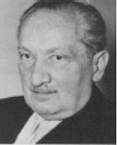
In the last 2 paragraphs I desperately try to depict the state of minds, or of mind-presenting (Befindlichkeit) and emotions (Stimmung) of a man, or a Cambodian monk to be more specific, experiencing the Hiroshima House and a vision-handicapped in the Helen Keller �Z���^�[, for without considering their emotion a critic of an architectural work and its users is impossible. And, if discussing people�fs minds and emotions, one ought to take Martin Heidegger (1884~1976) into account, considering his philosophy of Sein (being) and Dasein (to be being at the moment at that place) in his Being and Time (Sein und Zeit: ���݂Ǝ���) for at least 2 reasons.
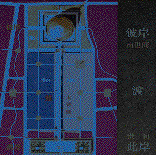 First, a human being is called Dasein and Sterbliche (Mortal) by Heidegger; each man or Dasein being in the world (In-der-Welt-Sein) is living a process of being towards Death (Sein Sum Tode: ���S�Ɍ�������). The death marks the completion of the process of any Dasein.
First, a human being is called Dasein and Sterbliche (Mortal) by Heidegger; each man or Dasein being in the world (In-der-Welt-Sein) is living a process of being towards Death (Sein Sum Tode: ���S�Ɍ�������). The death marks the completion of the process of any Dasein.
Heidegger dose not equate a Dasein with a Substance (Substanz: ���ݕ�, ����), and thus he does not talk about the questions like if a man is composed of his flesh and soul, or if incarnation or transmigration (���̗։�, �]��) does happen or not. Both a Christian and a Buddhist believe in an illusion of Heaven or Pure Land (��y) on the Other Shore (�ފ�); left is the plane of C.Y. Lee�fs current design, the Houmon Temple (�����@�厛) in China, indicating the theme: to ferry from the mundane World (����) towards the Other Shore (�ފ�). Yet,�@ Heidegger is concerned with the issue of how the death means to a living person and of how an alive shall face and deal with the unavoidable death.
Heidegger�fs attitude about death: one shall not ignore death by saying that it is an issue of not yet (Noch nicht), or pending (Ausstand); rather, one must seriously realize that death is approaching (Bevorstand). And, facing death, one must be able to switch his feeling from fear (Furcht: ��, ����) of death to anxiety (Angst: �s��) and respect. The switch is somehow like a Buddhist concept: kakugo (�o��: ������E���A�^������邱��). The difference between fear and anxiety can be understood by the Kamikaze airmen�fs attitudes towards death, for they knew their approaching deaths and yet they are willingly to process their missions without cold feet, and perhaps because of kakugo, they are admirable for their enduring capacity to face the processes of to be (Zu-sein) in their final courses. And, the Kamikaze airmen�fs no-fear attitude can be furthermore understood by Nietzsche�fs absolute or radical nihilism (der radikale Nihilimus) in that facing death or any form of disaster would pump up a man with the power of will (Wille zur Macht) to overcome any negative emotions and be reborn. And, since the Hiroshima House in Phnom Pehn is built for condolence of the dead in the war and genocide, one could see better, with Heidegger�fs philosophy of death, how the architectural design manages to help solace Cambodians, Japanese and people in general.
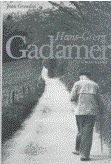 Second, by the Hans-Georg Gadamer (1900-2002) concept, the fusion of horizons, written in his Truth and Method (Wahrheit und Methode) puts it that the truth about a phenomenon in general is to be made clear with the fusion of various viewpoints from different horizons, for, observing a thing from a specific position one gets a perspective view only from his viewpoint and yet his image of the thing is incomplete unless he switches viewing position for different pictures. Criticizing the Hiroshima House within the horizon of Buddhism provides only a picture, and seeing it with reference to Heidegger�fs view of death and Nietzsche�fs European Buddhism, together with the Japanese and the Chinese horizons of Buddhism could offer the Hiroshima House a meaning beyond sole architectural critics.
Second, by the Hans-Georg Gadamer (1900-2002) concept, the fusion of horizons, written in his Truth and Method (Wahrheit und Methode) puts it that the truth about a phenomenon in general is to be made clear with the fusion of various viewpoints from different horizons, for, observing a thing from a specific position one gets a perspective view only from his viewpoint and yet his image of the thing is incomplete unless he switches viewing position for different pictures. Criticizing the Hiroshima House within the horizon of Buddhism provides only a picture, and seeing it with reference to Heidegger�fs view of death and Nietzsche�fs European Buddhism, together with the Japanese and the Chinese horizons of Buddhism could offer the Hiroshima House a meaning beyond sole architectural critics.
As said earlier, the Buddhism in Japan ever since Takatoku Tennou (�F���V�c645~54AD), has had to work together with Shintou in terms of kamibutsusyugou �_���K�� or Honjisuijaku �{�n��� and according to Nakamura Hajime (������: ���{�l�̎v�ҕ��@), the Japanese has developed a mentality in Buddhism, that the Japanese Buddhists are favored by Kami, the Japanese Deity. Also, according to Chang K. C, professor of History, Taiwan University, (������:���{���쎞��_���w�ґ�_���v�u��I����), in the Edo Period (1603�`1867), through the debates and editing among the Confucius scholars (��w��) and neo-Confucius scholars like Hayashi Razan (�ї��R: 1583~1657), or Kumazawa Banzan (�z���w�ҌF��R: 1619~ 91) or the military strategists (���w��) like Yamaga Sokou (�R���f�s: 1622~85) and Yoshida Shouin (�g�c���A1830~59), Japan is concluded to be the country with Divine origin (�_��) as her identity (or Subjectivity��̐�); as Hayashi Razan puts it, �gJapan is the Kami�fs (divine being) country.�h (�{�M�����ː_�V����: �ї��R���W). In principle, these scholars stress the points that although the Japanese �_�l�V�� and the Chinese ���l�V��are by and large similar, �_�l, the divine beings, are for sure different from���l, the Chinese Saints (like ꟁA�w�A�E�q�A�Ўq ).


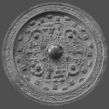
The kanji ��in the �_�l�̓� and the ���l�̓� is from Lao-tzu (�V�q), meaning the way towards wisdom or to the area of enlightened field of the Deity or the Saints; or, in Heidegger�fs word, �� (Tao) refers to the road (Weg) for a Dasein to be (Zu-sein) experiencing the process towards the area (die Gegend) in the clear, light-shining field (Lichtungstatte) in the forest (or, in the universe). Here, I shall briefly point out their �gby and large�h similarities and difference. In Hayashi Razan�fs�s�_���B���tand Kumazawa Banzan�fs�s�W�`�O�����t, both made a series of far-fetched literature and associated Mirror, Jade and Sword (���ʙ�) with the three virtues of all times�\Wisdom, Compassionate and Bravery (�q�m�E) in�s��L.���f�t, or Resolute, Kindhearted and Straightforward (��, �_, ����) described in ����. Chyuyou and Shousho are 2 of the 13 Chinese classics (�\�O�o). In�s���{���L�t, the Sun Goddess Amaterasu ohmikami (�V�Ƒ��_) handed down the Jade (����������),the Sword (����̙�), and the Mirror (���@�̋�) to the Jimmu Tennou (�_���V�c). Any Japanese knows the story better and still, I wish to say that the mirror (��), one of these three�_�̊�, other than symbolizing the divinity of the Japanese Imperial House, plays the role of media between the Sun Goddess and her descendants, perhaps for the Mirror�fs nature to reflect lights and images. A mere physical phenomenon though, the reflecting light for the ancient people can mean mystical messages perhaps from the unknown, heavenly world on the one hand, the mystical reflecting light may prevent people from being harmed by the evil spirits (�S��������) on the other. Incidentally, from the remains found from the tomb yards in the kofun-period (�Õ�����) around the 3rd century, lots of mirrors were unearthed and believed to be from China (and if interested, see ���юO�Y: �Õ��������̈Ӌ`. ���{�l�Êw�_�W).
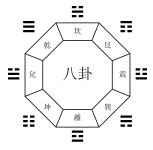
The point to bring up the sameness between the meanings of these�_�̊�, or the Japanese deity�fs identity, and the 3 Chinese classical virtues is to tell between (���l) the Saints and (�_�l) the Divine beings, (and Notice here that the issue of national identity is dealt with from the fusion of 2 horizons). Although written language was not there in the then Japan, claimed Kumazawa (�F��R:�s�W�`�O�����t), the virtues were there and represented by these�_�̊�. He said, for example, after a man was born his name was then given; in Chinese the calligraphy for ear and eye are����pronounced erh-muh: and in Japan�u�݂݂߁v; either����or�u�݂݂߁vrefers to the same things. And since no written language in the old Japan, these Mirror, Jade and Sword (���ʙ�) were employed to represent the virtues of the Japanese Deity: �u���{�V�ہC�O��_���, ���y�V��, �͂������T��v: Mirror (��) stands for Wisdom (�q), jade (��)for Compassionate (�m) and Sword (��) for Bravery (�E); likewise, in�Ռo, Bagua (���T; literally �geight symbols�h) stands for the philosophy of Taoism. Kumazawa further concluded that China has the Tao of Saints whereas Japan has the Way (Weg) of Deity (�u���Đ��l�V���v�o�u���{�_�l�V���v).
The Mirror, Hayashi (�ї��R) further added, also represents the Sun, the Jade (�ȋ�) for the Moon and the Sword for the Star. With the 3 kinds of light, the heaven and earth are thus bright; with the 3 divine tools the King�fs rules may then proceed. That the Emperor�fs rule is Divine is rational; (���ۓ�, �ʏی�, ���ې�, �L���O�����V�n��, �L�O��_�펧������, ����, �_��, ����). Hayashi and Kumazawa, not being as radical as the military strategists Yamaga Sokou or the scholars devoted in the principle of �gRevere the Emperor, Expel the Barbarians�h (��������) like Yoshida Shouin, are inclined to employ Confucianism to interpret Shintou and equate both in the same status. Here, in Hayashi�fs horizon, ���� refers to the ���{���Rand�_�� the throne of Tennou; he has an interesting point of differentiating Tennou and Shougun. The Calligraphy for the Kanji of 3 is�u�O�v, which refers to�u�V�n�l�v, heaven, earth and humans, and the Japanese Deity links�u�O�vtogether with the vertical stroke�u�P�vand makes�u���v�Cwhich is the Shougun. In����, the first man is the Lord under the heaven (���̐l�͓V���̌N��). The flame-like point right above the kanji�u���vmakes�u��v, which means master or, in Hayashi�fs saying, Amaterasu Ohmikami (�V�Ƒ��_) the Deity since the point above�u���vis like the flame of the Sun. What Hayashi wishes to do here is to distinguishing ����from �_��; both are important. The Emperor is the Master�u��v, governing Japan the�_��; the Shougun, representing the Emperor, rules the Deity�fs mundane people (�s�_���B���t). That is, Japan is in peace while the sacred and the common (���Ƒ�), the Devine and mundane (�_�Ɩ}, ��Ɖ�) or Tennon and Shougun (�V�c�Ə��R) are working hand in hand without conflicts.
About the association between (���ʙ�) and the three virtues: Resolute, Kindhearted and Straightforward (��, �_, ����), one major difference between�_�l�̓� and ���l�̓� is the interpretation of shoujiki (����); ���� in Chinese means�^��, �M�p, which is close to �܂���. For example, in Shousho (����: �^�͕�) there wrote the way of being a good King is�@trustworthiness (��������).
| �q�v��B | Shikou (one of Koushi�fs 10 best students) asks Koushi the way of politics. |
| �q�H�F�u���H�A�����A���M�V��I�v | �gGive people enough food, security or enough protection,�h replied Koushi, �gand�M�p: trustworthiness.�h |
| �u�K�s���ߎ����C�D�D�D�D�v | �gIf one or two has to be rid of,�c�h asks Shikou further, |
| �u�����D�v | �gMilitary protection.�h |
| �u���H�B���ÊF�L���A�����M�s���B�v | �gFood Supplies. People die anyhow. A King cannot rule without people�fs trustworthiness.�h |
According to Chang K. C, trustworthiness (�M�p) is a fine virtue much favored by the Chinese whereas the meaning of�܂���in�_�l�̓� is prone to loyalty (����). Just look at the true story of�ԕ�Q�m and Yoshida�g�c���A below.
The sonnoujyoui (��������) thinker Yoshida yet stressed the autonomy (or subjectivity) of Shintou, as quoted below from his original Chinese writing, demanding that Shintou be standing alone and be supported by both Buddhism and Confucianism; Shintou is the master whereas the Buddhism and Confucianism serve. Those who support the triple-sovereignty or be devoted to Buddhism or Confucianism are the foes of Shintou.
| �_�����A���A�H�O���C���]�ҁA�䖢�������B��A���A�����ȕ�_����B �_��毉Ȏ�A����ƁB�_���A�N��G��A���A����A����A�������^�N�C���A �����Ɖ��n���ƁB�R���ωāA�d�m����N�A�F�_����� |
| �i�������j�@�g�c���A�F��R�����e�@ |
For their loyalty to the Emperor, those sonnoujyoui (��������) scholars, eventually, were all badly treated by the Shogun�fs sovereignty (���{). Yoshida was sentenced to be kyuhshu (���O) on 21st, Nov. 1859; his head was chopped off and hung on a long wood post in public.
To say such as above is not to stir up a controversial and yet unnecessary topic, for the terminology - national identity - can be politically manipulated and intimidating. In fact, it is not uncommon for a race to have their own legend of origin; the Jewish regard themselves as the Selected Race, the Chinese as the descendants of dragon (���̒��n), and the Germans as der Uebermensch�\the man composed of the qualities of Napoleon Bonaparte and Wolfgang Goethe, as Nietzsche said, or a Julius Caesar with Christ�fs heart.
And, how does to say such as above have anything to do with the Hiroshima House in Phnom Pehn? There are two points. One, although the design concept is to prolong the memories of the horrors in genocides and seek to alert the coming generations, this architectural work, perhaps reminding them of the horrors, is unable to persuade its visitors into stopping their national identities, for a man has gasyu (�䎷), self-centerness, and so has a nation. The national identity is a double edged sword, serving to collect the nationals with a sense of glorified togetherness and yet filling up the collective minds with patriotic self-conceitedness; thus, wars recycle and genocides follow.
The design concept is said for the architecture society and the public. From the writer�fs view, the Hiroshima House reincarnates a phenomenon between our world and the supernatural via its mysterious space, which is like experiencing a state of being by a dual dialogue between the building and its human experiencers. The images of the Hinayana Cambodia and her inflicted history are merely the vehicles to help emerge the theme of the design and it is the vague reincarnated dialogue that makes this building powerful.
Two, its powerfulness could be best explained or seen from the horizon of Heidegger�fs thoughts of Dasein and the light-shining field (Lichtungstatte) in the forest. The Hiroshima House in Phnom Pehn is the light-shining field in the jungle of darkness and, likewise, the architect�fs maiden project Genan (����) is the Lichtung for a man to have a retreat where he encloses himself from the anxious (Angst: �s��), contemporary Japan, or the world in general. He presents in there (Befindlichkeit����, �o�Ȃ��Ă���) and fuses himself with fantasies, or unearthly illusion, by the manipulation of lighting and patterning of Genan. The word �gfantasy�h somehow is similar to �gdreaming�h to certain degree; both, in Heidegger�fs horizon, are private mental processes, or the individual mine-ness (Jemeinigkeit), which is explained below. The issue of Genan, designing strategy and the like, is different from the Hiroshima House and will be discussed later.
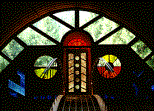

The term Dasein bears quality (A): to be being (Zu-sein) and (B): individual mine-ness (Jemeinigkeit). (A) refers to a man trying with any possibility to be (Zu-sein), or to survive with all his potentiality for being (Sein-koennen). A horse or any other animals may have the ability to be (Su-sein) yet the animals are not Dasein since they are unable to ask or even think about the question: what is being (����)? Dasein is a Being of Existence (Existenz), whereas the other entities (Seiendes/Substanz, beings���ݕ�), like the Hiroshima House or a Porsche 911, are either a Being/substance (���ݕ�) of present-at-hand (Vorhandenheit) or of ready-at-hand (Zuhandenheit). For example, as the brain surgeon Fukujima (������t) skillfully cut to open his patient�fs skull and successfully removed the tumor from the web of veins by his God�fs hand (�_�̎�) operating the micro-scope-aided equipment, he and his equipment are jointly in a ready-at-hand state; such Zuhandenheit state can be expressed by the phrase: (�l�n���), when a jockey and his horse working together as a whole to win the champion. For me though, the surgical tools and the horse are the entities (Substanz: ���ݕ�) of the present-at-hand kind (Vorhandenheit), for I don�ft know how to handle them.
Likewise, as the tangerine dragon, the Cambodian monks holding bowls for donated foods mentioned above, enter the Main Hall of the Hiroshima House and have their present-ness (Befindlichkeit����, �o�Ȃ��Ă���) been full of awesome emotions (Stimmung) and fused with the spatial mood: the sun rays, the fluting sounds, the falling rain beads and the sturdiness of the Main Hall, each monk is a Dasein experiencing the being (Zu-sein) in there, and the Hiroshima House is the ready-at-hand (Zuhandenheit) substance (Substanz: ���ݕ�). Notice here that I emphasize the individuality; i.e. they are a group of monks composed of several individual Dasein and each has his own mine-ness (Jemeinigkeit) - a Dasein�fs quality (B). However, for those who are monks because over 90% of Cambodians are monks, the Hiroshima House, as far as they are concerned, is a present-at-hand kind (Vorhandenheit) substance. Those monks, as Heidegger criticizes it in his Being and Time (Sein und Zeit: p. 127) are a kind of fallen (Verfallen: �ׂ�) Daseins (Das Verfallen des Daseins); a man usually live in the same way as most people (Das Man) live. They enjoy the pleasures in the manner as Das Man do; they read literature and criticize Arts as Das Man do; they are angry with a man about his beliefs or behaviors because Das Man are angry with the man about his so and so. In doing so, they feel safe and secure and yet they become self-restraint, inauthentic (uneigentlich: ��{����) fallen Daseins in their world shared (Mitwelt) with others. They are undetermined by people�fs idle talk (Das Gerede: ���ʘb), seducible by constant curiosity (Die Neugier: �D��S) and indecisive by ambiguity (Zweideutigkeit: �B����).
Each man, and billions of others (das Man) on earth, is categorized as a Homo sapiens, a Dasein can not be grouped in either a biological category or any social or professional class like a lawyer, a fisherman, ���E�l, an actress, a navy officer, �ێg��, a Cambodian monk and so on. Once a man is born, or thrown into the world - Geworfenheit, by Heidegger�fs word, he has no choice but to accept whatever imposed upon him and try to live through (the process of) his fate. Any Dasein differs from each other in that each has his own fingerprints; each Dasein has his own locus of life (�����̉ߒ��ƋO��), which is irreplaceable by others.
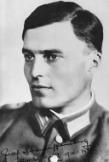
For example, the legendary Claus von Stauffenberg (1907 ~ 44), is categorized as a Colonel in the old German Army; yet, the process of his being (Zu-sein) is his own mine-ness (Jemeinigkeit). His early inclination to be a man of letter like Stefan George the poet was not granted and, by Geworfenheit, he was falling (Verfallen: �ׂ�) to chose to be a Cavalry officer�\the Knight of Bamberg. His battle experience in the North Africa theatre there he lost his right arm and left eye; and his call of conscience (Gewissen), together with his concern (Sorge) for his country, urged him to act the bomb plot in Rastenburg. The series of Zu-sein marks a bright locus of light-shining, clear field (Lichtungstatte) in the universe, as bright as the aura around a Buddha�fs head and irreplaceable by anyone�fs Zu-sein, certainly not by Tom Cruise or Mel Gibson. The Hollywood idols may act Graf Claus�fs career; they are unable to stare down the Fuehrer�fs eyes only because they are lacking of the Graf�fs astounding (Zu-sein) being.
Heidegger said that the conscience call is not from God but a projection from the inside of a Dasein through a silent, self dialogue, and if the Dasein is willing to accept the call and act on his conscience (Geweissen-haben-wollen) he is a Dasein with authentic mine-ness (Eigentlich Jemeinigkeit). For example, as the monks enter the Main Hall and have their present-ness (�o�Ȃ��Ă���) fused with the spatial atmosphere, those who are unauthentic (uneigentlich) monks, would answer the calls of consciences and switch their state-of-minds (Befindlichkeit: �S�̏��) to be pious. Notice that although over 90% of Cambodians are monks, some of them are monks imprisoned (verfangt: ����) by their public, social world (Mitwelt) of Buddhism. Why am I a Buddhist, is it because everyone is, by Geworfenheit? Why was Graf Claus a German Army officer? Why did they and others join the Zengakuren for Zenkyoutou (�S����) in 1968? Was it because of the disgust at McArthur�fs boys, or of Toudaisei�fs involvement? Or was it because some Dasein like to try the kind of being (Zu-sein) able to have a chat with Mishima in Yasuda Hall (���c�u��)? Perhaps a Dasein only wished to be (Zu-sein) in Zenkyoutou to show his ex-girl that he could act.
The Japanese people, seen from the writer�fs horizon, are in general easily inclined to fall into the whirlpool (Die Wirbel: �Q) of the public life. Just go see a baseball game in Tokyo dome or��ى�, and look at the cheering clouds, both sides, nearly everyone is holding a pair of hollow plastic sticks, the so-called �����X�e�B�b�N, red or white depending on which side they are on, beating the sticks in a rhythm, yelling �撣���ăG�c and shouting the names of the hot-shots. Why is that? Two possibilities are there. One, they are fallen (Verfallen: �ׂ�) in their society and imprisoned (verfangt: ����) by its trendy stereo type. Two, as a Japanese was born and educated, he is a grown-up bearing himself as a national having the traits of �܂���, ���A�� and so on. He has to be loyal to his school, his ���, the baseball team he chooses and his country; he would sacrifice his life for Japan if necessary. Murakami (����t��) is one of very few exceptions in the��ى�audience, holding a jumbo-size paper cup with ���r�[��, puffing away the white beer head and sniffing the amber fluid before he takes the action. Murakami�fs novels are popular perhaps because his heroes are always trying to be an authentic (eigentlich: �{����) Dasein.
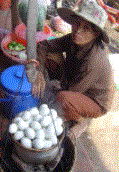
The Dasein begins his individual life-process, prepares a draft (Entwurf) for his future, or for his being ahead of Dasein itself (Sich-vorweg-sein) towards death (Sein Sum Tode). That is, a man/Dasein is always living a life-process full of worries about what may happen next, about something he is dealing with (Besorgen) and someone with whom he is concerned (Fuersorge). For example, look at the face of the duck-selling woman in the Central Market in Phnom Pehn; her facial expression and gesture show fear and worry, nothing but recycling anxiety. Such worrying state-of-mind (Befindlichkeit), concern (Sorge) and emotions (Stimmung) like anxiety (Angst: �s��) or fear (Furcht: ��, ����), �s�����Ƃ������ƂȂ�, are the source and energy by which a Dasein must try to be being in the world (Mitwelt) he shares with others. Because of her fear and anxiety, she has to sell her duck-eggs, like it or not. A man has to keep doing so with all he can until the completion of Dasein: death. Admiral Yamamoto (�R�{�\�Z), as being thrown into his then Japan (Mitwelt), has no choice but to obey the order and struggle to be the architect of Pearl Harbor raid against his belief of an eventual disaster.
�@The theme, �e�[�}, of Hiroshima House, I presume, is the matter of facing death and ascending beyond. It is unfair, in terms of its complexity of function, to call it a Souin, a Monastery (�m�@), although I state above that this building is designed for enlightening man, for its form and spatial plan are not associated with any temple in Cambodia. It is unfair, either, to call it a cemetery (������n) for the Cambodian holocaust, since the dead were not buried there. Yet, seeing from how the architect designs it, I wish to call it a grave station (�挊�w) from there the dead ascend to the Pure Land for deliverance, ��E�Ə�y�ւ̉w. A grave station, obnoxious in name though, symbolizes a transitional point from death to rebirth. Writing this, I quite often image myself acting the jizouou (�n����) descending down to the hell for saving the inflicted. Or also, I image myself to be (Zu-sein) a prisoner in S-21. It is sweating hot and hundreds of rose-gold head flies are everywhere, droning and circling the human wastes and the blackened blood stains as if bees were humming around blossoms near the honey-farm. Sudden shrieks at midnight a few cells away kept me alert and afraid; the horrors of facing torturing scenes at any moment, of being betrayed by jail-mate or of being forced to betray others for staying alive, made death itself a relief. And I, if a Cambodian monk, would abandon all the egoistic senses, love, hatred, or self-centeredness, all those out of Gasyu (�䎷), preparing at any moment, while living in S-21, to enter the Pure Land (��y) in the Other Shore (�ފ�), because death was approaching (Bevorstand). Struggling through the darkness I was waiting desperately for the sun light, or even the rainfall, for, somehow, light and the water falling from sky seem to me divine. How can a monk manage to face S-21 without fear? It is because he was trained by the desperation and pushed up to the mental state of Muga (����). Muga literally means non-self, a metaphysical concept and yet the mind state any Buddhist is struggling to reach for deliverance (��E). This is why I bring up Heidegger, Nietzsche and Descartes in order to understand both Muga and the meaning of the Hiroshima House.
�gI think therefore I am,�h said Descartes, which is probably the most well-known statement in the school of Rationalism (������`). Here, Nietzsche objects it by criticizing the linguistic rule embedded in the Indo-European language trees; i.e., a sentence must contain a �gSubject�h and a �gPredicate,�h plus additional Complement(s) and Adjunct(s).
| Ich denke | vs. | Es denkt |
| I think | vs. | It think(s) |
| S | | | P | | | C | | | A |
| I | think/consider | this matter | seriously |
For Descartes, it is the Subject �gI�h that makes the thinking process possible, and understandably, this statement is made upon the ground of Rationalism. Yet, Nietzsche propositions that the subject �gI�h is not the condition of the predicate expressing the mental process of thinking. And rather, the process of thinking itself is the condition; i.e., in the process of thinking, the �gI�h is fictitious, and it is �git�h that is processing thinking. I like to make 2 examples below: First, in Japanese, a sentence without Subject is grammatical:
| ||||||||||
| ||||||||||
| ||||||||||
| �{�{�P�u�D�x�v |
Second, in practicing the Japanese tea ceremony (����), while the tea master (���l)is processing the tea-serving, he would begin by preparing a pot of fresh hydrangea (���z��) in the tea house, burning the water, preparing the tea sets, a bamboo tea whist (���), a tea ladle (���|����), tea cups (�����q) and other fine, delicate accessories. Everyone, the tea master and those being served, all sitting cross-legged on the matted room, watching, adoringly, the���lholding the tea whist circling the tea powder with hot water in���q, enjoying the mental state of self-oblivion, bouga (�Y��) or Muga (����), without the minds of worrying about your bank account, about���̃��C�o��, etc. This bouga mental state can be said: it is the process itself that is watching the tea ceremony processing, rather than I am watching�c. That is, in the tea house, that who is practicing tea ceremony is not the concern; rather, what is important is the mental process (Werden) itself that dominates the mind of each participant. And this mental process, in Buddhism, is corresponding to the so-called 8th sense: arayashiki (�����뎯).

Heidegger seems to be an admire of Lao-tzu (�V�q); the founder of Taoism 3 centuries B.C. said�@�gI have a big problem, for I have myself.�h (��L�劳�A�B��L�g).What Lao-tsu means by �gI have myself�h is, on a par, I have Gasyu (�䎷). The �gI�h in the sentence of Lao-tzu is like the �gI�h in Descartes�f �gI think therefore I am.�h It is false-self (����), for false-self cannot control but true-self (�^��) can (���). ��� means a mental state of freedom without any emotional burden: ���R����. For instance, I cannot control my emotion, my desire, my hatred to my foes and yet, if my mental state is corresponding to the 8th sense: arayashiki (�����뎯), such emotional acts in my mind, suffering or joyful, are nothing by bubble images. Say, in Diamond Sultra (�����ʎ�g�����o), there writes: �gthe mundane affairs are all caused by karma, they are nothing but bubble-like illusions, vanishing as quickly as lightning or morning dews.�h (��ؗL�ז@, �F�����A�e, �@�I���@�d, �c��@����.)
In fact, by saying �gI have a big problem, for I have myself,�h Lao-tzu implies that he buys the concept of �L���F��in the Diamond Sultra: all the forms of being are false. The �gevil angel�h Kashiwagi (����)in Mishima�fs kinkakuji (���t��) says that the Ryouanji Temple is nothing but a pile of rocks:
�u������������������̂��B�D�t�A�����A�l�Ԃ̍l������I�Ȃ��́A�����������̑S�Ă̛����͕s�тȖ��@�I�Ȃ��̂ȂB����������Ȃ����A�ɉ߂��Ȃ��E�E�E�v
He is right; one shall never have his mind be controlled by any image. In other words, the meaning of the well-known phrase in Buddhism�\Vexation and annoyance are wisdom (�ϔY�����)�\is to switch man�fs state of mind from Vexation to enlightenment (���) and deliverance (��E). This switching process can be understood by Heidegger�fs Dasein; that is, a man is living through experiencing a series of beings (or processes), and the series of beings (Sein) is neither objective (�q�ϓI��), concrete things, nor fixed or immutable (�s��). A Dasein is a series of consistently changing processes.
Experiencing the facade, the spaces of the Hiroshima House is like experiencing the process of tea ceremony; both makes both significant by practicing Practical (Praxis) philosophy. That, is, just do it, to employ a commercial from Nike the sports shoes.
Buddhism, said Nietzsche in Der Antichrist, is the only actually positivistic religion (die einzige eigentlich positivistische Religion�jand, compared to Christianity, is more realistic (realistischer). Perhaps in terms of Hinayana, he called it egoism (Egoismus), for it practically teaches the disciples to raise their spiritual power (Macht) and have delight�iHeiterkeit�j. So, below I shall see how the architect designs to offer the users the image of grave from there deliverance and enlightenment are near. I wish to borrow Nietzsche�fs oppositional attitude to Nihilism, compare it with several notions in Zen Buddhism and study how the theme is processed and made in this design. In short, Nietzsche believed that Buddhism is a religion of the Negative Nihilism. And, since life is vanity�iUmsonst�j, one must struggle, going through the Positive Nihilism, and reach the radical Nihilimus, then one shall accept the eternal recurrence (�i����A) (ewige Wiederkunft des Gleichen) and love his ill fate (amor fati) with his will power (Wille zur Macht). This is exactly what Nietzsche�fs phrase: the reaffirmation of the will to live in the face of death is all about.
It is a philosophy of practice (Praxis), which makes the fukkoujyutaku (�����Z��) and the Hiroshima House in Phnom Pehn meaningful. The late Dr. Floyd Schmoe was a Mahayana Buddhist, as I called him one earlier above, because he actually acted; �s��, to employ Mishima favorite words, he built houses for the Hiroshima people. And hopefully, to make the philosophy of practice (���s�N�w) understood, I show below how I practice Mahayana; it may sound absurd in the horizon of Rationalism; I did it nevertheless.

For the past 7 x 7 = 49 days I have chanted the True Will Sutra of Jizou, Ksitigarbha Bodhisattva �u�n�U��F�{���S�v, once each day, for the dead in the Pol pot holocaust, believing the waves of my chanting of Jizoukyou could be reverberated and heard by Jizou and urging the dead ashore to the Pure Land. Chanting, and simultaneously, imaging cross-legged sitting on the cool, tangerine Vietnam tile paved 3rd floor in the Main Hall of the Hiroshima House, facing the huge staircase, either meditating with my eyes fixed on the light beams raying from beside the silhouetted Bussoku (����) above, or counting my breath, feeling the rain droplets silk-cutting my forehead, I, or it, was delighted although the throat burning like tonsillitis sore. Whose throat was burning? Maybe the sore throat, or perhaps my Arayashiki, is the affect (Affekt) for
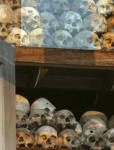

going on chanting. In each process of chanting, my mind, or�O��, was moving with the images of the slowly moving light and shadow projecting on the tilted V typed posts as if processing the fire-offering (�����̉�). The horizontally alternating concrete and brick walls turned out to be the defensive borders (���E) for my offering (�@_�{�Ǝ{�H), and the hollowed bricks inserted on the walls, hundreds and thousands of skulls in the relatively dark hall, seemed moving up with the light rays; the ghost posses appeared again, perchance from the Cambodian jungle or from the 4th dimension, chanting the holy name of Jizou sama together with the sore throats, stepping up to the giant stair and upward to the air in the western sky. The process lasted 65 solid minutes, 70 if necessary, then I came to myself from my 8th sense, Arayashiki (�����뎯); I cracked a raw egg, left it in the glass and bathed it with a pour of Glenmorange; seeing the amber liquid etching the sunny yolk and albumen, I washed down my aching throat with a gulp, �S������. I, the false self (����), deserved it.
As per Nietzsche, who is doing the thinking (or the chanting in the above case) is not the concern, rather, what urges the process of thinking itself to go on is; and it is the will power of a Dasein that affects the process; the process is regarded as Werden (becoming) or Process. The Dasein here is, for sure, the man who is thinking, but the man is not the Sein. At this point perhaps I may call my physical form with my sore throat the Substanz (substance) while the processing of chanting Jizoukyou for the dead is the Werden. Substanz and Werden are 2 different matters. And what urges my sore throat to go on chanting is, in Nietzsche�fs term, the will power that affects (Affekt) the Dasein to process, while it is Arayashiki (�����뎯), or Ginraikura (�@�ґ�) that keeps me going. For those who are interested in Ginraikura (�@�ґ�), please see�ђJ�����s�{�o�v�z�ᔻ�t(�呠�o�ŁA1989) ���{�j�N�s���N�Ƌ�__�@�ґ��v�z�ᔻ�t(�呠�o�ŁA1989).
Habitually, I do this in the Christmas week, chanting the Jizoukyou for the killed soldiers, Germans and Russians, in Stalingard and St. Petersburg; in the Chinese New Year week for the killed in the Chinese theatre and the following civil war; and in the lunar July, the ghost month (�S�̌�), which happens to be the month of the Obon (���~) festival, for the dead in the atomic bomb disasters, in Dachau, Auschwitz Birkenau,�c In the lunar July, which is August, Chinese believe that the ghosts, the people died with sin, are liberated form Hell for a month. For example, on the lunar 7th July (���^), the Ox Boy (���Y) may meet his beloved Weaver (�D��) on the rainbow bridge in Heaven; for the rest 11 month they are kept in Hell owing to their adultery, a sin forbidden in the Ureriten (_���V). A practicing Buddhist understands what I have been doing. If you are a Japanese Buddhist, please try to do what I do, seriously, from the day Yoshinaga Sayuri is reading the poem for the commemoration (�����L�O��) in the Hiroshima Peace Center, once a day for 7 days. If you are not, please try to do so, Be Divine! Imagining sitting in the Red Cross Hospital ruin, you and I are watching the city virtually leveled. There was hardly a wall more than a man�fs tall still standing. The civilians were gone, killed or evacuated. Not even a dog was found, perhaps all eaten for lacking food supplies. Forget Rationalism (������`) for a moment, believe in�O��like a Japanese Ninjya (�E��); read the (���E) chant in mind: �Օ�馎ҊF�w��ݑO, and then ���V��F���쎝 for (�@_�{�Ǝ{�H)�B
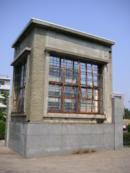
|
�ԏ\���a�@���k��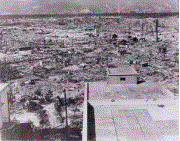
|
| �L���ԏ\���a�@�O�ɂ��錴���̔��@���Řc�S���̑��g�ƌ����̈ꕔ |
�una ma ji zou ou bo satsu�v(�얳�n������F)�I
�una ma ji zou ou bo satsu�v(�얳�n������F)�I